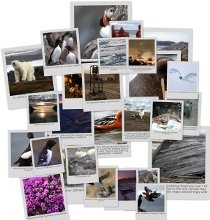There where the little bird flies
 Little auk is the most abundant bird species on Svalbard. As many other sea bird species, little auks are long living and can sometimes reach the age of 30. A little auk pair lays an egg every year, but success in breeding (i.e. that the egg develops to an adult) is a rare occasion. They eat small nutritious zooplankton, which has a high fat content due to the extreme seasonality in the Arctic. While feeding their chicks little auks are doing two kinds of hunting trips: short and long ones. Short trips last only for some hours and are done to the waters close to their colonies. During these trips birds are collecting food for their chicks. Whereas long trips are done when a parent's energy reserves are getting so depleted that it can not continue chick rearing without a break. These trips can last for days. Typically another one of the parents heads for a long trip, while the other one is carrying food for their chick. Naturally the more long trips adults are completing and the longer the trips last, the worse is the breeding success and, eventually, the year.
Little auk is the most abundant bird species on Svalbard. As many other sea bird species, little auks are long living and can sometimes reach the age of 30. A little auk pair lays an egg every year, but success in breeding (i.e. that the egg develops to an adult) is a rare occasion. They eat small nutritious zooplankton, which has a high fat content due to the extreme seasonality in the Arctic. While feeding their chicks little auks are doing two kinds of hunting trips: short and long ones. Short trips last only for some hours and are done to the waters close to their colonies. During these trips birds are collecting food for their chicks. Whereas long trips are done when a parent's energy reserves are getting so depleted that it can not continue chick rearing without a break. These trips can last for days. Typically another one of the parents heads for a long trip, while the other one is carrying food for their chick. Naturally the more long trips adults are completing and the longer the trips last, the worse is the breeding success and, eventually, the year.
Little auks are flying speeds about 40-50 km/h. While heading out for a long trip, they rest about half of the time and rest on the water the second half. One flight to feeding waters can take as long as ten hours. It is easy to calculate that during these trips the birds could fly very far from their colonies. Destinations for long trips probably vary from a year to year and are still largely a mystery for the people working with little auks.
One of this field season's goals was to look more deep into this mystery. We tried to deploy mini-GPS loggers on the birds to see, where they were flying, but the trial fell into technical problems. Loggers weren't technically strong enough take the Arctic challenges. Batteries did not work in cold water. A couple of weeks ago we went for a cruise trying to follow the birds flying out from their colonies. Huge densities of birds at the Ice-edge, just west from the legendary Whales bay confirmed the educated guess. These little birds are flying hundreds of kilometers only to find the fat plankton living at the edge of the Arctic sea ice zone.





0 kommenttia:
Post a Comment